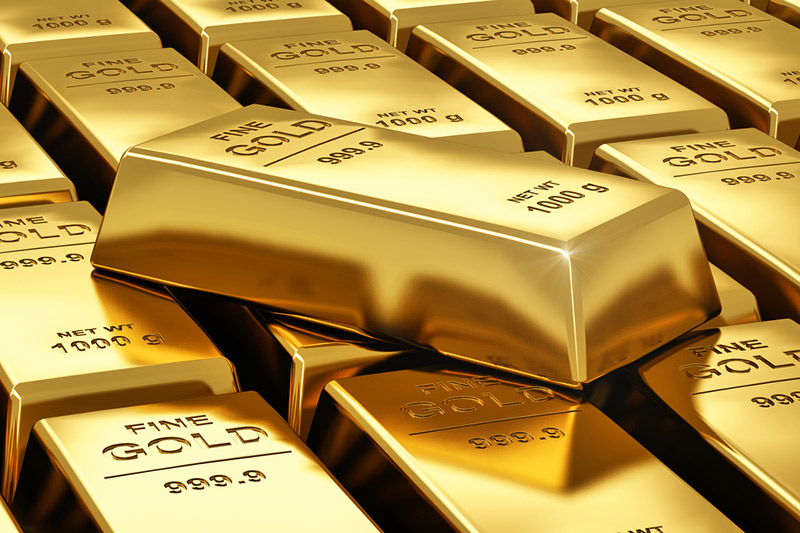Investing.com - Gold futures eased down in lackluster trade on Wednesday, as market participants took profits from a three-day rally that took prices to a one-week high on Tuesday.
On the Comex division of the New York Mercantile Exchange, gold futures for June delivery traded at USD1,658.95 a troy ounce during early U.S. morning trade, dipping 0.1%.
The June contract traded in between a range of USD1,654.15, the daily low and a session high of USD1,662.05.
Prices rose to USD1,663.95 on Tuesday, the highest since April 3.
Gold futures were likely to find support at USD1,613.55 a troy ounce, the low from April 4 and resistance at USD1,685.25, the high from April 2.
Gold prices rose nearly 3.5% in the three sessions leading up to Wednesday, including a rally of more than 1% in the previous session as the safe haven appeal of the precious metal re-emerged amid fears that Spain will be the next country in the euro zone to require a bailout.
Traders continued to monitor developments surrounding the fourth largest economy in the euro zone. Speaking before the Spanish Parliament earlier, Prime Mister Mariano Rajoy said that the country’s deficit target remains “unconditional”.
Spanish 10-year yields eased slightly to 5.86% in early trade Wednesday, from 6.01% on Tuesday, while Italy’s 10-year government bond yield stood at 5.5%, after rising to as high as 5.73% on Tuesday.
Analysts at HSBC Holdings said in a report late Tuesday that the precious metal may be “decoupling from risk assets and resuming its more traditional role of safe haven.”
For much of the last year, investors' typical reaction to bad news from Europe was to buy gold, as it boosts the safe haven appeal of the precious metal, but that relationship unraveled in September, with gold futures moving largely in line with other commodities and risk-sensitive assets.
Meanwhile, gold traders continued to asses the implications from last week’s dismal non-farm payrolls data from the U.S.
The weaker-than-expected jobs report revived expectations that the Federal Reserve may implement a third round of quantitative easing, which would weaken the dollar and drive gold prices higher.
Gold investors will be closely watching U.S. data in the second quarter for clues as to the likelihood of a fresh round of monetary easing.
French lender Societe Generale said in a report earlier that, “If weak data continues, the Fed will have to intervene again to stimulate consumption."
"The next couple of years will be really challenging for global growth and central banks will be relied on as a crutch to get us through."
Expectations of monetary stimulus tend to benefit gold, as the metal is seen as a safe store of value and inflation hedge.
Elsewhere on the Comex, silver for May delivery shed 0.2% to trade at USD31.60 a troy ounce, while copper for May delivery dipped 0.1% to trade at USD3.649 a pound.
On the Comex division of the New York Mercantile Exchange, gold futures for June delivery traded at USD1,658.95 a troy ounce during early U.S. morning trade, dipping 0.1%.
The June contract traded in between a range of USD1,654.15, the daily low and a session high of USD1,662.05.
Prices rose to USD1,663.95 on Tuesday, the highest since April 3.
Gold futures were likely to find support at USD1,613.55 a troy ounce, the low from April 4 and resistance at USD1,685.25, the high from April 2.
Gold prices rose nearly 3.5% in the three sessions leading up to Wednesday, including a rally of more than 1% in the previous session as the safe haven appeal of the precious metal re-emerged amid fears that Spain will be the next country in the euro zone to require a bailout.
Traders continued to monitor developments surrounding the fourth largest economy in the euro zone. Speaking before the Spanish Parliament earlier, Prime Mister Mariano Rajoy said that the country’s deficit target remains “unconditional”.
Spanish 10-year yields eased slightly to 5.86% in early trade Wednesday, from 6.01% on Tuesday, while Italy’s 10-year government bond yield stood at 5.5%, after rising to as high as 5.73% on Tuesday.
Analysts at HSBC Holdings said in a report late Tuesday that the precious metal may be “decoupling from risk assets and resuming its more traditional role of safe haven.”
For much of the last year, investors' typical reaction to bad news from Europe was to buy gold, as it boosts the safe haven appeal of the precious metal, but that relationship unraveled in September, with gold futures moving largely in line with other commodities and risk-sensitive assets.
Meanwhile, gold traders continued to asses the implications from last week’s dismal non-farm payrolls data from the U.S.
The weaker-than-expected jobs report revived expectations that the Federal Reserve may implement a third round of quantitative easing, which would weaken the dollar and drive gold prices higher.
Gold investors will be closely watching U.S. data in the second quarter for clues as to the likelihood of a fresh round of monetary easing.
French lender Societe Generale said in a report earlier that, “If weak data continues, the Fed will have to intervene again to stimulate consumption."
"The next couple of years will be really challenging for global growth and central banks will be relied on as a crutch to get us through."
Expectations of monetary stimulus tend to benefit gold, as the metal is seen as a safe store of value and inflation hedge.
Elsewhere on the Comex, silver for May delivery shed 0.2% to trade at USD31.60 a troy ounce, while copper for May delivery dipped 0.1% to trade at USD3.649 a pound.
